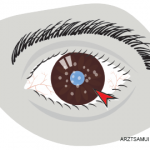NEW YORK (Reuters Health)—Intraocular vancomycin may lead to potentially blinding hemorrhagic occlusive retinal vasculitis (HORV), a new study suggests.
“The importance of this study was to present in a number of patients overwhelming evidence that rarely, intraocular vancomycin is associated with sight-threatening retinal vascular occlusion,” says lead author Dr. Andre J. Witkin of Tufts Medical Center in Boston.
“We collected a retrospective case series of 36 eyes of 23 patients who had severe retinal damage after routine cataract surgery that we believe was related to a hypersensitivity reaction to intraocular vancomycin, an antibiotic frequently injected in the eye during cataract surgery to prevent endophthalmitis,” he tells Reuters Health.
The findings were published online on Jan. 19 in Ophthalmology.1
For the study, Dr. Witkin and his colleagues emailed surveys to members of the American Society of Cataract and Refractive Surgery (ASCRS) and the American Society of Retina Specialists (ASRS) asking for information about cases of suspected HORV.
The websites of both societies share an online registry of HORV cases and have formed a joint task force to study the clinical characteristics of HORV, as well as its cause, prevalence, treatment and outcomes. The authors found additional cases through a literature search of historical data, including intraoperative characteristics, images, treatments and outcomes.
All 36 eyes had received intraocular vancomycin, 33 by intracameral bolus, one by intravitreal injection and two through an irrigation bottle.
Patients who developed HORV typically had one unremarkable day-one post-op undilated exam, delayed-onset vision loss with no pain, mild anterior chamber and vitreous inflammation, sectoral intraretinal hemorrhages in ischemic areas and a tendency toward venules and peripheral involvement.
Patients asked to be treated for HORV one to 21 days after surgery or intravitreal injection and they generally had poor visual results: 22 eyes (61%) had 20/200 or worse visual acuity and eight (22%) had no light perception. Neovascular glaucoma occurred in 20 (56%) eyes.
Of the seven eyes given additional intravitreal vancomycin after surgery, the visual acuity in five was no light perception at the most recent examination; in one eye it was 20/400 and in one 20/800; three eyes given intravitreal corticosteroids had final acuities of 20/40, 20/70, and hand movements.
“The findings are surprising because intraocular vancomycin is thought to be very safe and has been used for many years by many ophthalmologists without any known toxicity or hypersensitivity,” Dr. Witkin says.
“There is still no definitive evidence that the reaction causing HORV is caused by hypersensitivity to vancomycin. Unfortunately, skin testing is not helpful for type 3 hypersensitivity, the type we believe is occurring in these patients, and there is currently no other test available to definitively determine whether a hypersensitivity reaction to vancomycin is the culprit,” he added.


